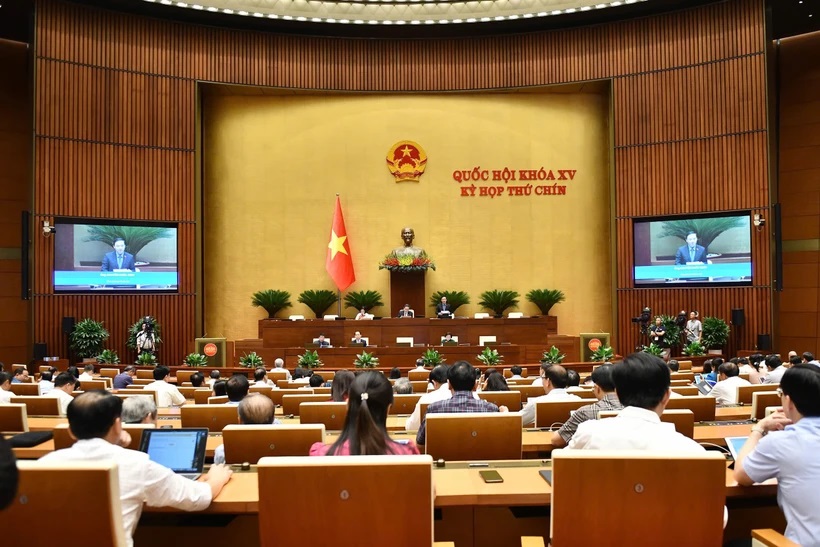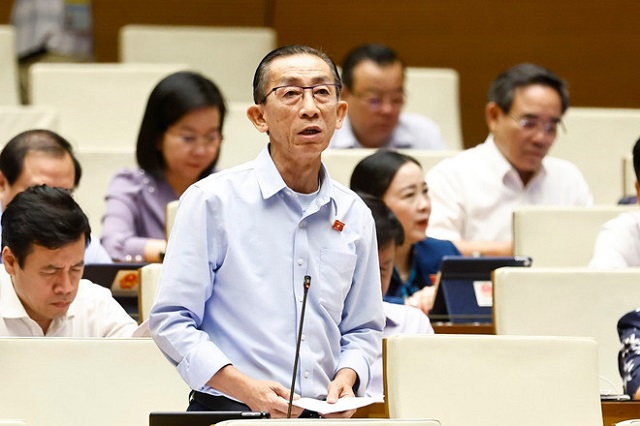
The 9th session of the 15th National Assembly. (Photo: quochoi)
|
The rearrangement of provincial-level administrative units is expected to not only reduce budget costs but also provide additional development incentives and space.
This was shared by delegate Tran Hoang Ngan during the discussion session on the rearrangement of provincial-level administrative units in 2025, which took place on the morning of June 12.
According to delegate Tran Hoang Ngan (Ho Chi Minh City delegation), in the current context of the Fourth Industrial Revolution, with the Internet of Things, artificial intelligence, big data, and the digital government, society, and citizens, there is an opportunity to streamline the political system and merge or consolidate provinces and cities. He considered this a necessary policy that would contribute to reducing budget burdens and improving state management efficiency.
“By reducing the number of provinces and cities from 63 to 34, including six merged from three localities and 20 coastal ones, we not only reduce budget costs but also gain development incentives and space. The combination of provinces and cities is not just an addition of area and population but also a multiplication of GDP,” said delegate Tran Hoang Ngan.
However, the delegate also emphasized the need for investment and a flexible institutional framework that suits the population scale, economic characteristics, and security and defense requirements of each locality. He also stressed the importance of enhancing decentralization and empowering localities with the principle of “local decision-making, local implementation, and local accountability.”

Ho Chi Minh City National Assembly Delegate Tran Hoang Ngan speaks. (Photo: VNA)
|
The Ho Chi Minh City delegation suggested prioritizing resources for localities to invest in synchronous economic and social infrastructure, especially transportation and digital infrastructure, to promote digital governance in local management and administration.
Using the example of Ho Chi Minh City’s merger with three localities – the industrial hub of Binh Duong, the logistics and marine economic center of Ba Ria-Vung Tau, and Ho Chi Minh City’s strengths in finance, commerce, trade services, and science and technology, Delegate Tran Hoang Ngan believed that this would create a golden triangle for the country. As a result, the new Ho Chi Minh City, which currently contributes a quarter of the country’s GDP and a third of its total state budget revenue, would undoubtedly contribute even more in the future.
The delegate also mentioned the potential for new dynamic quadrangles for Ho Chi Minh City, such as the Cai Mep- Thi Vai international transshipment port combined with the Can Gio transshipment port, the formation of a free trade area and an international financial center in Ho Chi Minh City, and the Long Thanh international airport in Dong Nai province, which would create a significant new driving force for the Southeast region.
Delegate Nguyen Huu Thong (Binh Thuan province) affirmed that the policy of rearranging provinces and centrally-run cities is a strategic and urgent decision to improve governance and reorganize development space in a sustainable and connected manner, leveraging scale advantages and optimizing resources.
“This is an opportunity to comprehensively restructure the regional development model, redistribute population, infrastructure, and investment resources according to new strategic orientations, contributing to the rapid and sustainable development of each locality and the country,” said Delegate Nguyen Huu Thong.
Regarding the merger proposal, the Binh Thuan province delegate suggested completing the institutional framework and laws suitable for a two-tier local model and providing a special organizational mechanism for the new provinces during the transition period.
He also recommended promptly resolving policies for officials, public employees, and laborers who have to leave their jobs, providing retraining and job support, and ensuring stable living conditions for those who have to move to new locations after the merger.
In particular, the Binh Thuan province delegate proposed prioritizing transportation infrastructure connectivity, especially in localities with large areas after the rearrangement, such as the new Lam Dong province, which is expected to be the largest in the country, covering mountainous, midland, and coastal areas.
To overcome difficulties, the delegate requested that the National Assembly and the Government pay attention to allocating resources to upgrade National Highway 28 and National Highway 27 and consider approving the planning of a new expressway connecting the three localities before 2030. He also emphasized the efficient use and rearrangement of public assets to avoid waste and maximize their value.

National Assembly Delegate Pham Van Hoa of Dong Thap province speaks. (Photo: VNA)
|
Similarly, Delegate Pham Van Hoa (Dong Thap province) expressed his strong agreement with the policy of rearranging provincial-level administrative units. He shared that many National Assembly delegates had proposed policies for officials, and he requested that the competent authorities pay attention to this matter.
“There are mixed feelings among our colleagues. Some are happy, while others are sad. Some are happy because they have power and authority, but others are sad because they have to move from a leadership position to a deputy position or even a staff position,” Mr. Hoa shared. Another concern is the relocation of officials, which can affect their family life and work. Therefore, it is essential to provide political and ideological encouragement to officials, and he requested that the competent authorities pay attention to this matter.
Quang Hanh
– 09:50 12/06/2025

















